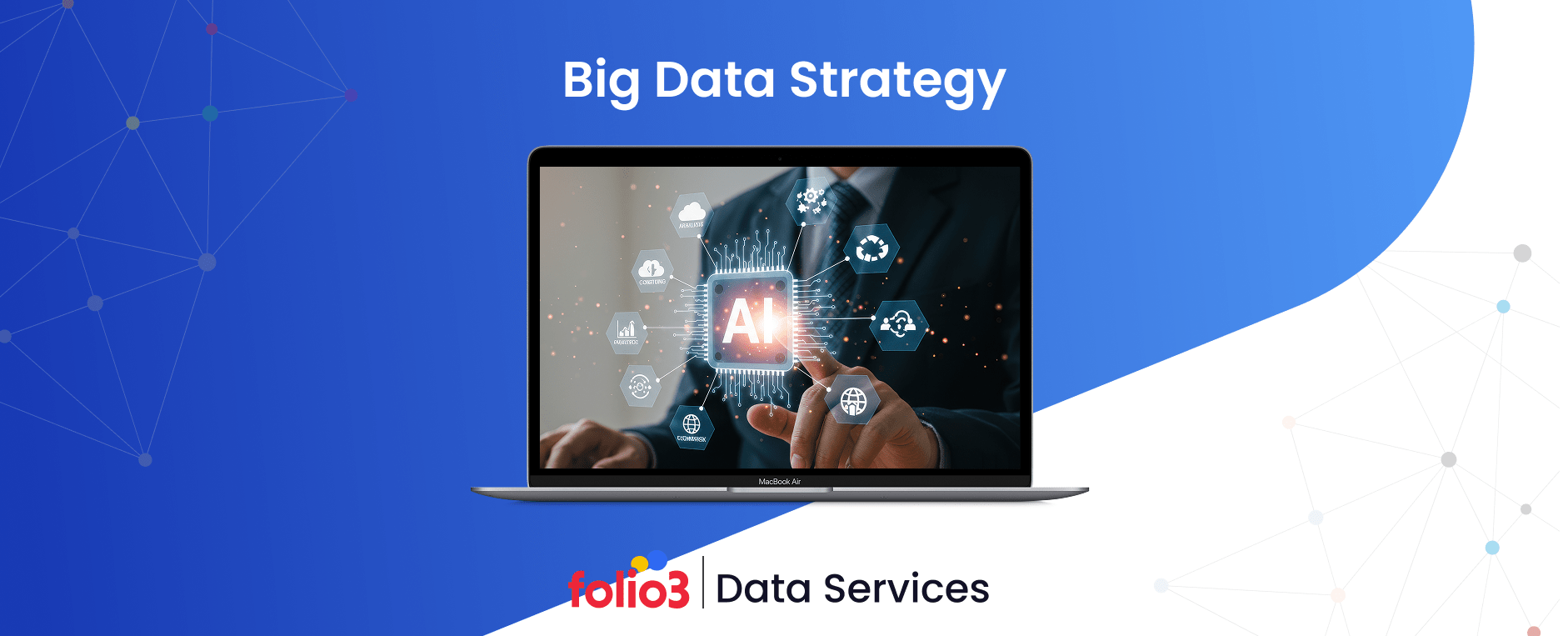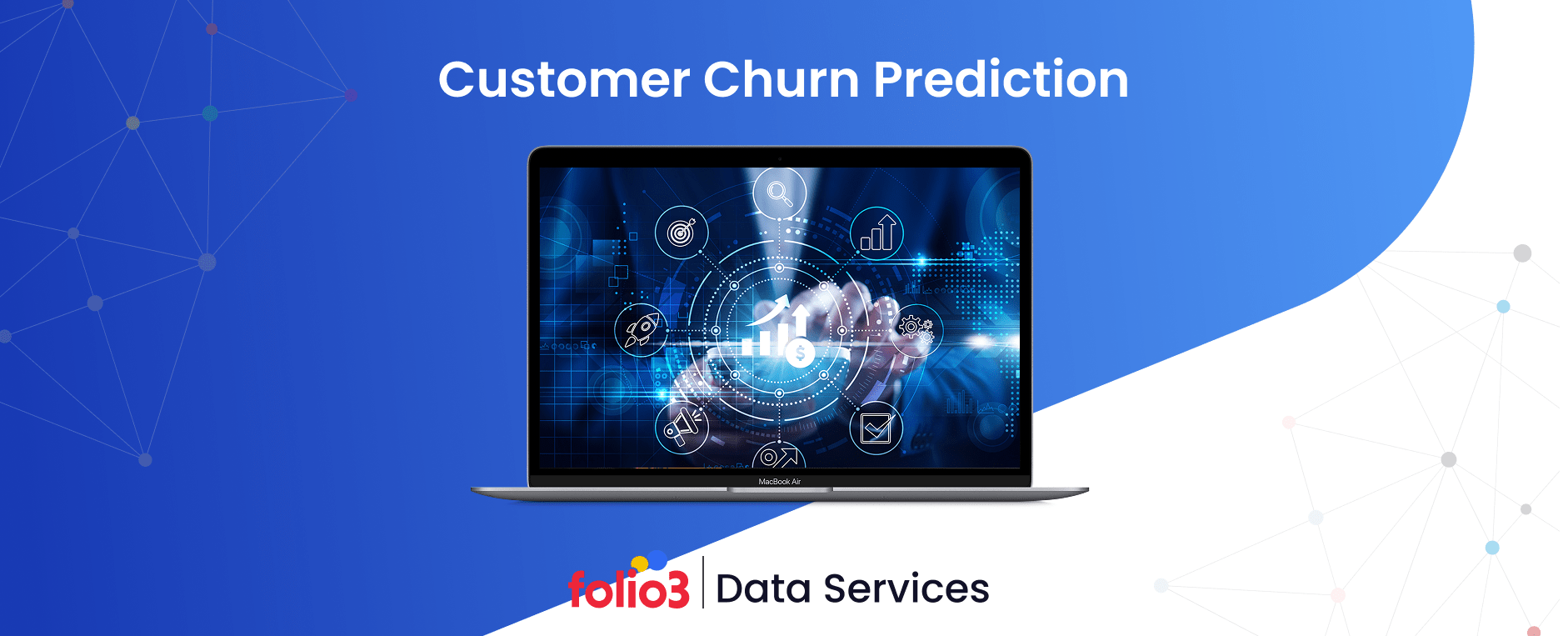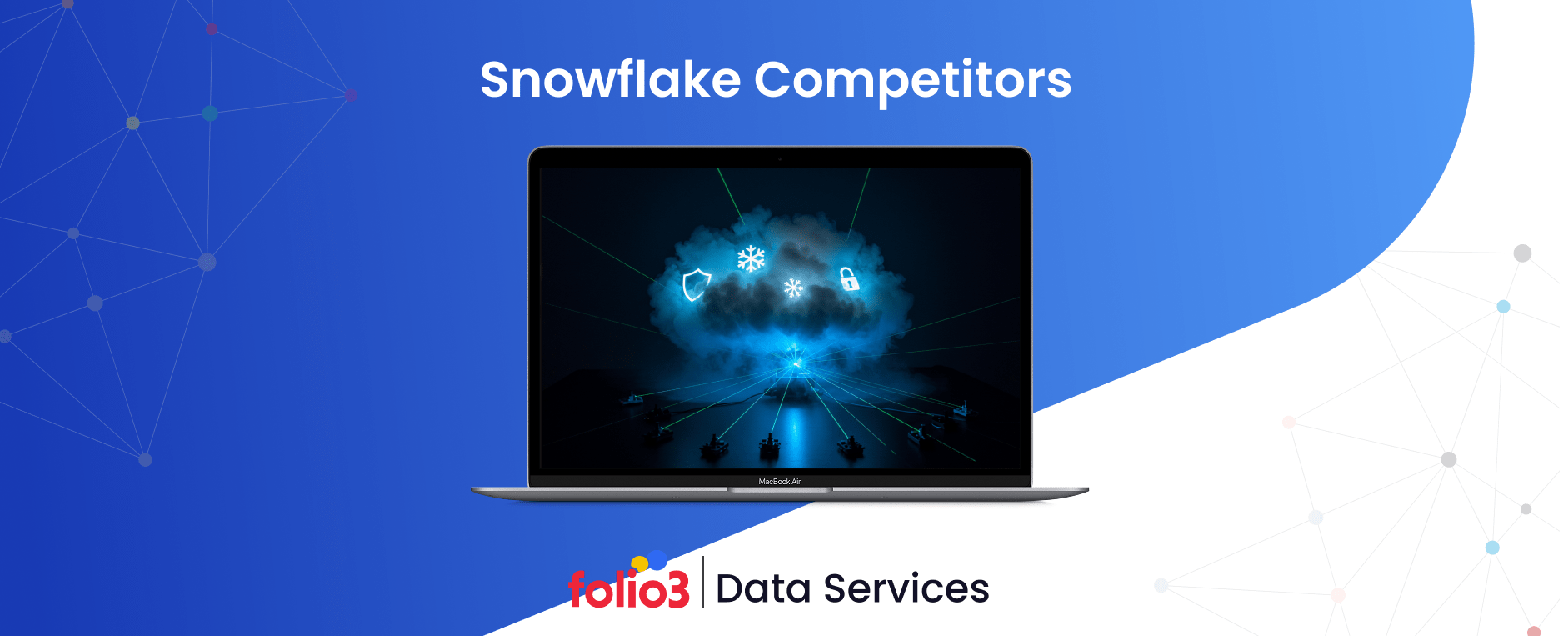Every organization collects information but only those with a strong big data strategy know how to turn it into business value. The difference between having data and harnessing its power lies in strategic intent and execution. A big data strategy defines how a company captures, stores, processes, and analyzes massive volumes of data to align insights with measurable business outcomes.
Without a structured big data architecture strategy, even the most advanced technologies can create silos, inconsistent data quality, and missed opportunities. Many organizations invest in analytics tools yet continue to rely on intuition because they lack a roadmap connecting data capabilities to core objectives. A comprehensive big data analytics strategy bridges this gap by ensuring that every data initiative serves a clear business purpose.
When properly implemented, a big data strategy enhances decision-making, improves operational efficiency, and uncovers competitive advantages. It transforms raw data into actionable insights that drive profitability, innovation, and customer satisfaction.
This guide explores the essential components of building a robust big data strategy from governance and architecture design to analytics implementation and success measurement offering practical insights, real-world examples, and expert recommendations to help businesses maximize the potential of their data.
What is Big Data Strategy?
A big data strategy is a comprehensive plan that defines how your organization will leverage large-scale data assets to achieve its business goals. It encompasses the technologies, processes, people, and governance structures needed to turn raw data into a competitive advantage.
Unlike tactical analytics projects that address specific questions, big data strategy takes a holistic view. It considers what data you’ll collect, where you’ll store it, how you’ll ensure quality, who can access it, what analytics capabilities you’ll build, and how insights will flow into business processes. The strategy serves as a blueprint guiding investments and priorities across multiple years.
The “big data” designation matters because scale changes everything. When you’re analyzing thousands of records, spreadsheets work fine. When you’re processing billions of events daily from IoT sensors, web interactions, and transaction systems, you need different architectures, tools, and approaches. A big data strategy addresses these scale challenges while keeping business value as the guiding principle.
Why Every Business Needs a Big Data Strategy Today?
In the modern digital economy, having a big data strategy is no longer optional, it’s essential for survival and growth. As customer expectations evolve, companies like Amazon and Netflix have redefined personalization through advanced big data analytics strategies that anticipate user behavior. Today’s consumers expect every interaction to be intelligent, timely, and relevant that’s something only achievable through data-driven insights.
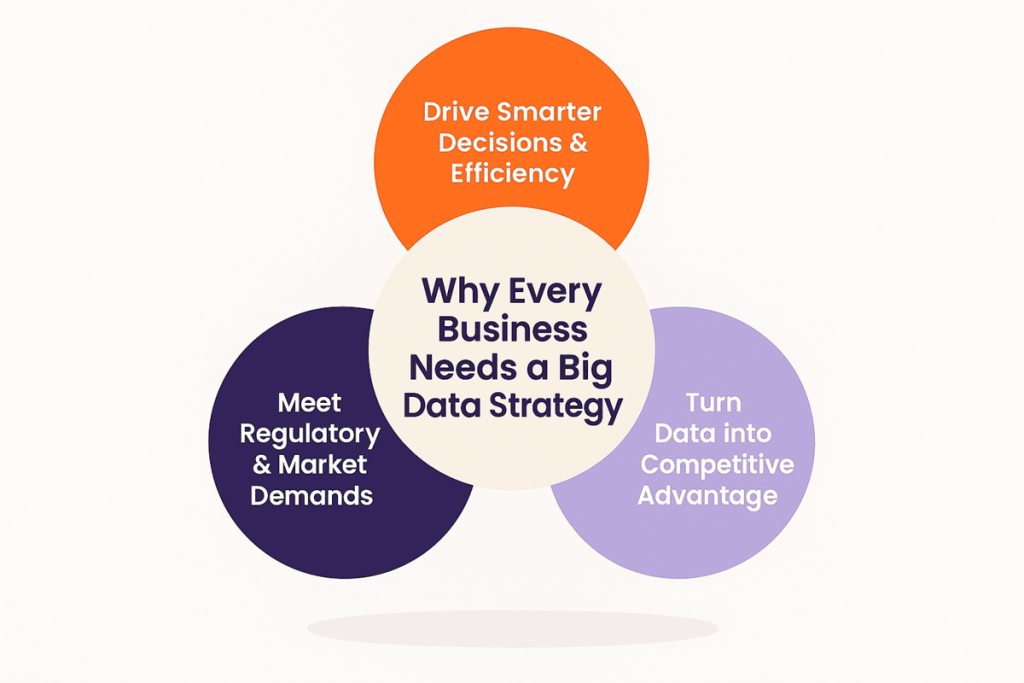
Competing Through Intelligence and Efficiency
Operational complexity has surged across industries. Global supply chains, manufacturing IoT sensors, and dynamic market conditions generate vast volumes of data every second.
Without a big data architecture strategy, organizations risk drowning in this complexity rather than mastering it. Businesses that effectively use data to predict demand, optimize production, and enhance decision-making gain a measurable competitive edge.
Regulatory and Market Pressures
Regulations such as GDPR and CCPA demand robust data governance frameworks—something only a well-structured big data business strategy can support. At the same time, IDC predicts global data will reach 175 zettabytes by 2025, making effective management crucial.
Data as a Competitive Asset
Companies that embed big data into their decision-making processes achieve sustainable advantages. According to MIT Sloan, organizations with mature big data strategies generate 2.6x higher revenue growth than competitors. In short, a clear strategy transforms overwhelming data into a strategic asset that drives innovation, compliance, and profitability turning information into true business value.
Components of a Successful Big Data Strategy
Effective strategies share common structural components that work together as an integrated system, including:
Data Governance & Quality Management
Governance defines who owns data, who can access it, what standards apply, and how you ensure compliance. Without effective governance, data quality deteriorates, security vulnerabilities arise, and regulatory non-compliance occurs.
Quality management establishes processes for validating accuracy, completeness, consistency, and timeliness of information. Poor quality data produces misleading analytics that undermine trust. Organizations need clear ownership, defined standards, automated quality checks, and processes for resolving issues.
Data Architecture: Cloud, On-Premises, Hybrid
Architecture decisions shape what’s technically possible and economically feasible. Cloud platforms like AWS, Azure, and Google Cloud offer scalability without requiring capital investment, but they also create ongoing operational costs and potential vendor lock-in.
On-premises infrastructure offers control and predictable costs, but it requires a significant upfront investment and ongoing maintenance. Hybrid approaches balance these tradeoffs, keeping sensitive data on-premises while using the cloud for less critical workloads. The right choice depends on your data volumes, security requirements, budget constraints, and technical capabilities.
Analytics Capabilities: Descriptive, Predictive, Prescriptive
Descriptive analytics answers “what happened” through reports and dashboards showing historical performance. Big data and predictive analytics utilize statistical models and machine learning to forecast future outcomes based on patterns in large and diverse datasets.
Prescriptive analytics recommends specific actions by simulating different scenarios and their likely outcomes. Mature strategies build all three capabilities, starting with descriptive analytics as a foundation and progressing to predictive and prescriptive as sophistication grows.
Security & Compliance Considerations
Data breaches cost organizations an average of $4.45 million, according to IBM’s 2023 Cost of Data Breach Report. Security must be architected into systems from the outset, not added later.
This includes encryption at rest and in transit, access controls based on the principle of least privilege, audit logging of all data access, and regular security assessments. Compliance requirements vary by industry and geography, but universally demand knowing what data you have, protecting it appropriately, and demonstrating compliance through documentation.
How to Build a Big Data Strategy in 7 Steps?
Strategic development follows a logical progression from objectives through implementation and optimization. Here’s how you can build a big data strategy:
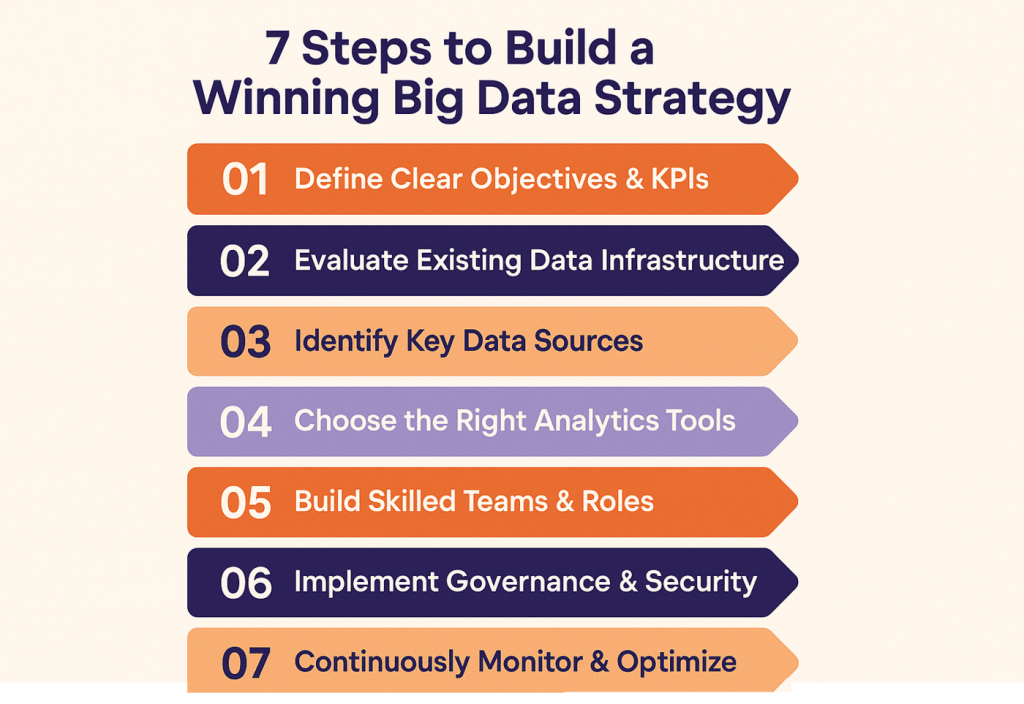
Step 1: Define Objectives & KPIs
Start by identifying specific business outcomes you want to achieve. Vague goals, such as “become data-driven,” fail because they can’t guide decisions or measure progress. Instead, define concrete objectives: reduce customer churn by 15%, decrease supply chain costs by 10%, or improve product recommendation accuracy by 20%. Each objective needs measurable KPIs that show whether you’re making progress. These metrics become the scorecard for evaluating investments and priorities.
Step 2: Assess Data Infrastructure
Inventory your current state honestly. What data sources exist? What storage and processing capabilities do you have? Where are the gaps between current capabilities and what objectives require?
Many organizations discover they’re collecting data they don’t use while lacking data they need. Assessment reveals whether you can build on existing infrastructure or need fundamental changes. Document technical debt that creates constraints and maintenance burdens.
Step 3: Identify Data Sources
Map all relevant data sources, both internal and external. Internal sources include transaction systems, customer relationship management platforms, operational databases, and application logs.
External sources might include social media feeds, third-party market data, weather information, or competitive intelligence. Evaluate each source’s value in relation to its objectives, data quality, accessibility, and cost. Prioritize high-value sources you can realistically integrate.
Step 4: Select Analytics Tools
Tool selection depends on use cases, user skills, scale requirements, and budget. Business intelligence platforms, such as Tableau and Power BI, serve descriptive analytics needs. Statistical packages and machine learning frameworks enable predictive modeling.
Cloud data warehouses, such as Snowflake and Databricks, handle large-scale processing. Open-source tools reduce licensing costs but increase support burden. Select tools that seamlessly integrate with existing systems and align with your team’s capabilities.
Step 5: Build Teams & Roles
Data strategy requires diverse skills working together. Data engineers build big data pipelines and infrastructure that enable seamless data flow across the organization. Data scientists develop analytical models. Business analysts translate between technical capabilities and business needs. Data stewards ensure quality and governance.
Leadership provides vision and resources. Small organizations might combine roles, while larger enterprises need specialized teams. Define roles clearly, establish effective collaboration processes, and identify capability gaps that require hiring or training.
Step 6: Implement Governance & Security
Establish data governance frameworks before problems occur. Define data ownership with clear accountability for quality and compliance. Create policies for data access, retention, and usage.
Implement security controls protecting sensitive information. Document processes for handling breaches, privacy requests, and regulatory audits. Governance seems bureaucratic, but prevents expensive problems and enables confident data usage.
Step 7: Monitor & Optimize Strategy
Strategy isn’t static. Market conditions change, technologies evolve, and organizations learn what works. As you implement big data initiatives, establish regular reviews assessing progress against KPIs, technology performance, user satisfaction, and emerging opportunities.
Celebrate successes while honestly evaluating failures. Adjust priorities based on results. The best strategies evolve continuously rather than remaining fixed for years.
From roadmap design to full implementation, Folio3 turns your strategy into a real-world data success story.
Advantages of a Strong Big Data Strategy
A well-designed big data strategy turns raw information into measurable business value, empowering organizations experience the following benefits:
Improved Decision-Making
Accurate, real-time data allows leaders to make evidence-based decisions instead of relying on intuition. With an effective big data analytics strategy, marketing teams can refine campaigns using performance insights, operations managers can detect bottlenecks, and product teams can prioritize features based on user data. Regular strategy assessment ensures these decisions remain aligned with evolving business goals, compounding small improvements into long-term competitive advantage.
Streamlined Operations
An optimized big data architecture strategy uncovers inefficiencies across business functions. Manufacturers predict equipment failures before they occur, retailers balance inventory levels to avoid stockouts, and logistics teams optimize routes to save time and costs. These efficiencies directly enhance productivity and profitability.
Enhanced Customer Insights
By understanding customer behavior and preferences, businesses can personalize experiences, predict churn, and identify high-value segments. This data-driven personalization like Amazon’s recommendation engine drives loyalty and long-term value.
Competitive Advantage and Revenue Growth
A robust big data business strategy creates differentiators competitors can’t easily replicate. From better forecasting and dynamic pricing to improved customer retention, data-driven organizations experience consistent revenue growth.
Proactive Risk Management
Big data enables early detection of risks from fraud and compliance violations to equipment failures reducing losses and maintaining business continuity. Ultimately, a strong big data strategy transforms data from a byproduct into a strategic asset that fuels sustainable growth.
Agile vs. Traditional Approaches to Big Data Strategy
Implementing a big data strategy requires balancing speed, flexibility, and governance. Traditional approaches emphasize detailed planning, stability, and compliance, while Agile methodologies prioritize adaptability, rapid delivery, and continuous improvement.
Choosing the right approach or blending both can determine the success of your big data architecture strategy. The table below highlights the key differences between the two models and how organizations can leverage their strengths for sustainable data-driven growth.
| Aspect | Traditional Approach | Agile Approach |
| Planning Horizon | Multi-year, detailed plans with rigid milestones | Rolling quarterly or sprint-based priorities |
| Requirements | Comprehensive specifications defined upfront | Evolving requirements refined iteratively through sprints |
| Implementation | Linear, phase-based (design → build → deploy) | Parallel development and deployment for faster delivery |
| Stakeholder Engagement | Limited to initial requirements gathering | Continuous feedback and collaboration throughout the process |
| Value Delivery | Large-scale releases after months or years | Incremental value delivered in short, frequent cycles |
| Risk Profile | High risk concentrated near final deployment | Risks distributed across multiple iterations |
| Adaptability | Difficult to pivot once project begins | Flexible and responsive to changing priorities |
| Team Structure | Siloed specialists working independently | Cross-functional teams working collaboratively |
| Success Metrics | Measured by adherence to original plan | Measured by speed of delivering business value |
| Best For | Stable environments and regulatory compliance | Fast-changing markets and innovation-driven projects |
Big Data Strategy Tools & Technologies
Choosing the right tools is the cornerstone of a successful big data strategy. The following technologies shape your ability to store, process, and analyze data efficiently transforming information into business value:
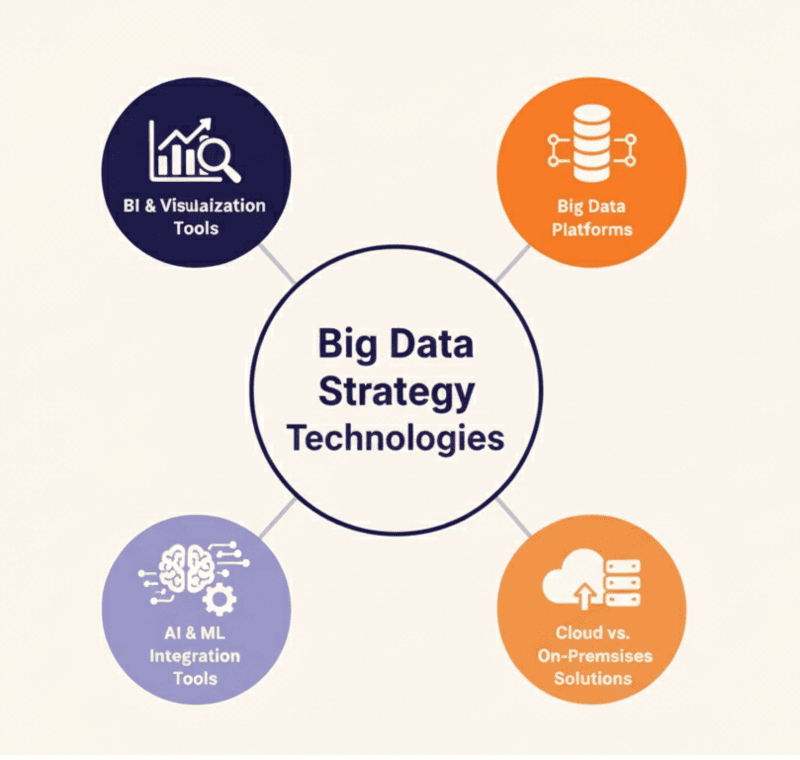
- Big Data Platforms: Foundational systems like Hadoop, Apache Spark, Snowflake, and Databricks power large-scale data storage and processing. Hadoop supports distributed data handling, while Spark enables real-time analytics. Snowflake offers cloud scalability, and Databricks merges analytics with machine learning. The right platform depends on your big data architecture strategy, technical expertise, and scalability needs.
- Business Intelligence & Visualization Tools: Platforms like Tableau, Power BI, and Qlik convert raw data into interactive dashboards, enabling teams to make informed, data-driven decisions. Effective integration with data platforms ensures smooth insight delivery across departments.
- AI & Machine Learning Integration: Advanced analytics in big data strategies leverage tools like AWS SageMaker, Azure ML, and TensorFlow for predictive modeling and automation. These tools help transform raw data into actionable foresight.
- Cloud vs. On-Premises Solutions: Cloud services (AWS, Azure, Google Cloud) offer scalability and flexibility, while on-premises systems provide security and control. Many organizations adopt hybrid models, balancing performance, compliance, and cost efficiency within their big data analytics strategy.
How to Measure Big Data Strategy Success?
Measuring the success of your big data strategy ensures continuous improvement and demonstrates tangible business impact. Here’s how you can:
- Define Key Metrics: Start by aligning success metrics with business goals track churn reduction, forecast accuracy, or cost optimization. Combine business KPIs with technical indicators such as data quality, system performance, and user adoption rates to gauge overall effectiveness.
- Track Operational Efficiency: Evaluate how your big data analytics strategy enhances productivity. Measure time saved in reporting, reduced manual data handling, and faster decision-making cycles all of which directly improve operational efficiency.
- Evaluate Analytics Impact: Assess how insights influence actions. Metrics like model accuracy, adoption rates, and implemented recommendations show whether analytics are driving real business change.
- Monitor ROI: Compare benefits like revenue growth, cost savings, and risk mitigation against technology and staffing investments. A well-implemented big data strategy roadmap delivers measurable returns and long-term strategic value.
Challenges in Big Data Strategy Implementation
Implementing a big data strategy is not just a technical initiative, it’s an organizational transformation that demands planning, expertise, and alignment. Some of the challenges you may face when implementing big data strategy include:
Data Quality and Management
Poor-quality data is the most common barrier to success. Inconsistent formats, missing values, and outdated records can derail analytics. Effective big data strategies require robust governance frameworks, standardized integration processes, and continuous data validation to ensure accuracy and reliability.
Handling Volume, Variety, and Velocity
The core challenge of any big data architecture strategy lies in managing scale. Massive data volumes, diverse formats (text, video, IoT), and rapid data flow require advanced big data storage, processing, and streaming technologies to maintain performance and relevance.
Infrastructure and Scalability
Legacy systems struggle under modern workloads. Upgrading infrastructure or migrating to scalable cloud platforms is crucial for supporting big data analytics strategies that demand speed and flexibility.
Skills and Talent Gaps
Shortages in data engineering, AI, and analytics expertise hinder execution. Businesses must invest in training or partner with big data strategy consulting firms to bridge the skills gap.
Change Management and Alignment
A successful big data business strategy depends on cultural adoption. Leadership must champion data-driven decision-making and manage resistance to new processes. Without alignment, even the most advanced tools fail to deliver value.
How Folio3 Helps You Tackle Big Data Challenges?
Building and executing a big data strategy requires more than tools it demands expertise, architecture, and execution. That’s where Folio3 Data Services comes in. Our end-to-end solutions help businesses overcome the challenges of data integration, governance, and analytics with scalable, intelligent frameworks tailored to each client’s goals.
Strategy Consultation
Folio3’s big data strategy consulting team helps you define objectives, assess capabilities, and design a roadmap aligned with business outcomes. With proven cross-industry experience, we accelerate time-to-value and ensure strategic clarity from day one.
Data Architecture Design
Our experts develop scalable big data architecture strategies—whether cloud, on-premises, or hybrid. We design robust data infrastructures using technologies like AWS, Snowflake, Azure, and Databricks to ensure flexibility, scalability, and long-term performance.
Data Integration & Engineering
We specialize in integrating fragmented systems and transforming raw data into actionable assets. From ETL pipeline design to real-time streaming solutions, Folio3 simplifies complex data ecosystems and ensures consistency across all sources.
Analytics & Visualization Implementation
Turning data into insight is where we excel. Our big data analytics strategy services include custom dashboard development, predictive analytics, and AI-driven insights to empower data-informed decisions.
Data Governance & Quality Management
Folio3 helps organizations establish governance frameworks that ensure compliance, maintain data accuracy, and promote transparency, key pillars of any sustainable big data business strategy.
Let’s transform your data challenges into measurable growth. Explore how our tailored services can fit your business needs.
Real-World Big Data Success Stories
These proven examples demonstrate what’s possible with effective strategy execution:
Walmart’s Real-Time Inventory Optimization
Walmart processes over 2.5 petabytes of data hourly from customer transactions, supply chain operations, and external sources. Their big data strategy optimizes inventory across over 10,000 stores, predicting demand using machine learning models that account for weather, local events, and seasonal patterns.
The system reduced out-of-stock situations by 16% while decreasing excess inventory, resulting in annual savings of hundreds of millions. Real-time price optimization adjusts in response to competitive pricing, inventory levels, and demand forecasts.
Netflix’s Personalized Content Recommendations
Netflix’s recommendation engine drives 80% of viewer activity, analyzing viewing patterns across 230 million subscribers. Their big data strategy combines collaborative filtering, deep learning, and A/B testing across hundreds of variables. Beyond recommendations, data informs decisions on content acquisition and production.
Netflix knew “House of Cards” would succeed before filming started based on viewer preferences for Kevin Spacey, David Fincher, and political dramas. This data-driven content strategy enabled them to spend $17 billion annually on content, achieving higher success rates than traditional studios.
Uber’s Dynamic Pricing and Route Optimization
Uber processes over 15 million trips daily, using big data to match riders with drivers, optimize routes, and implement surge pricing, balancing supply and demand. Machine learning models predict demand patterns accounting for time, location, weather, and events.
Route optimization takes into account real-time traffic, historical patterns, and predicted conditions. The strategy reduced wait times by 30% while improving driver utilization and earnings.
Coca-Cola’s Supply Chain Optimization
Coca-Cola integrated data from production facilities, distribution networks, retailers, and sales teams to optimize their global supply chain. Predictive models forecast demand at regional levels, enabling better production planning and inventory management.
IoT sensors in vending machines trigger restocking automatically. The company reduced distribution costs by 20% while enhancing product availability through improved demand forecasting and enhanced supply chain visibility.
Emerging Trends in Big Data Strategy
The industry of big data strategy continues to evolve rapidly as organizations seek smarter, faster, and more efficient ways to harness information for competitive advantage.
Real-Time Analytics and Streaming Data
Traditional batch processing is being replaced by real-time analytics powered by technologies like Apache Kafka, Flink, and cloud-native streaming platforms. Businesses can now act on live insights for fraud detection, operational optimization, and customer experience enhancement, moving from retrospective reporting to instant decision-making.
AI-Driven Automation
Artificial intelligence now drives automation across the data lifecycle. From AutoML platforms that create predictive models to NLP-powered analytics enabling conversational data queries, AI reduces manual effort and democratizes access to advanced analytics.
Techniques such as AI based data extraction further accelerate insight generation by automatically identifying and structuring information from complex, unstructured sources, making big data strategy implementation faster and more scalable.
Edge Computing and IoT Integration
With the rise of connected devices, edge analytics processes data near its source to minimize latency and bandwidth costs. This enables faster, smarter decisions for IoT-driven industries like manufacturing, logistics, and autonomous systems.
Data Monetization and Personalization
Organizations increasingly view data as a strategic asset. Through data monetization and hyper-personalization, companies unlock new revenue streams and enhance customer engagement while balancing compliance with privacy and governance regulations.
FAQs
What is a big data strategy and why is it important for businesses?
A big data strategy is a roadmap for using large-scale data to achieve business goals. It ensures data initiatives align with objectives, improving decision-making, operational efficiency, and overall business value.
How do you create an effective big data strategy?
Build an effective big data strategy by defining objectives, assessing infrastructure, selecting tools, and implementing governance. Continuous optimization ensures alignment between data insights and business outcomes.
What are the key components of a big data strategy?
A strong big data architecture strategy includes governance, scalable infrastructure, advanced analytics, and robust security, all integrated to drive consistent, actionable insights.
Which tools and technologies are commonly used in big data strategies?
Big data strategies use platforms like Hadoop, Spark, Snowflake, and Databricks for processing, alongside BI tools like Power BI or Tableau for analytics and visualization.
How can businesses measure the success of their big data strategy?
Measure big data strategy success through ROI, efficiency gains, model accuracy, and improved decision-making outcomes that directly impact growth and cost reduction.
What challenges do organizations face when implementing a big data strategy?
Challenges in big data strategy implementation include poor data quality, limited scalability, talent shortages, and resistance to organizational change.
How does a big data strategy differ from a traditional data analytics approach?
Unlike traditional analytics, a big data analytics strategy handles massive, varied, and real-time datasets—driving enterprise-wide insights instead of isolated reports.
What are some best practices for building a successful big data strategy?
Best big data strategy practices include setting clear goals, ensuring governance, adopting agile implementation, and investing in skilled data teams.
How does AI and machine learning fit into a big data strategy?
AI and ML enhance big data business strategy by automating analysis, predicting outcomes, and delivering prescriptive insights that improve decision speed and accuracy.
What are the future trends in big data strategy?
Future big data strategies will focus on real-time analytics, AI-driven automation, edge computing, and data monetization to unlock new business opportunities.
Conclusion
Big data strategy transforms information from a byproduct of business operations into a strategic asset, driving competitive advantage. A strong big data strategy transforms raw information into a powerful driver of growth, efficiency, and competitive advantage.True success lies in aligning data capabilities with business objectives through clear, results-oriented roadmaps.
Partnering with Folio3 Data Services enables organizations to overcome data challenges, streamline integration, and experience practical insights. With end-to-end expertise in data analytics, governance, and architecture, Folio3 empowers businesses to make smarter decisions, enhance performance, and achieve lasting success in today’s data-driven landscape.
